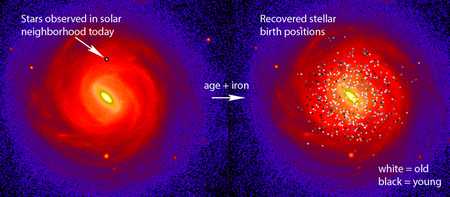Uncovering the birthplaces of stars in the Milky Way

Using precise stellar age and iron content measurements, the stellar birth places could be recovered.
Credit: AIP/I. MinchevAn international team of scientists led by Ivan Minchev of the Leibniz Institute for Astrophysics Potsdam (AIP) has found a way to recover the birth places of stars in our Galaxy. This is one of the major goals in the field of Galactic Archaeology, whose aim is to reconstruct the formation history of the Milky Way.
Stars in galactic discs have long been known to wander away from their birth sites owing to a phenomenon known as “radial migration”. This movement across the Galaxy severely hampers inferences of the Milky Way formation history. Radial migration is influenced by a number of parameters that are still poorly known: for example, the size and speed of the Galactic bar, the number and shape of spiral arms in the Galactic disc, and the frequency of smaller galaxies colliding with the Milky Way during the past 10 billion years and their respective masses.
To circumvent these obstacles, the scientists devised a way of recovering the Galactic migration history using the ages and chemical composition of stars as “Archaeological artifacts”. They used the well-established fact that star formation in the Galactic disc progresses gradually outwards, following that stars born at a given position at a particular time have a distinct chemical-abundance pattern. Therefore, if the age and chemical composition (its iron content, for example) of a star can be measured very precisely, it becomes possible to directly infer its birth position in the Galactic disc without additional modeling assumptions.
The team used a sample of about 600 solar-neighborhood stars observed with the high-resolution spectrograph HARPS mounted on the 3.6 m telescope of ESO’s La Silla Observatory in Chile. Thanks to the very precise age and iron abundance measurements, it was found that these stars were born all across the Galactic disc, with older ones coming more from the central parts.
Researches can now use this method for calculation of birth places even for stars not in the original sample. For example, given the age of our Sun of 4.6 billion years and its iron content, it could be estimated that the Sun was born about 2,000 light years closer to the Galactic center than it is currently located.
Minchev comments: “Once in the possession of birth radii, a wealth of invaluable information could be gained about the Milky Way past, even from this small number of stars with precise enough measurements available to us at this time.” Co-author Friedrich Anders adds: “In the near future, applying this method to the extremely high-quality data from the Gaia mission and ground-based spectroscopic surveys will allow much more exact measurements of the migration history and, thus, the Milky Way past.”

Left: A sample of about 600 stars situated very close to the Sun was used (approximate volume shown by arrow). Right: Using precise stellar age and iron content measurements, the stellar birth places could be recovered. Older stars were found to arrive preferentially from the inner parts of the disk (lighter coloured dots), while younger ones (darker coluored dots) were born closer to their current distance from the Galactic centre. The background image shows a simulation of a galaxy similar to the Milky Way for perspective.
Credit: AIP/I. MinchevImages
Using precise stellar age and iron content measurements, the stellar birth places could be recovered.
Left: A sample of about 600 stars situated very close to the Sun was used (approximate volume shown by arrow). Right: Using precise stellar age and iron content measurements, the stellar birth places could be recovered. Older stars were found to arrive preferentially from the inner parts of the disk (lighter coloured dots), while younger ones (darker coluored dots) were born closer to their current distance from the Galactic centre. The background image shows a simulation of a galaxy similar to the Milky Way for perspective.
Big screen size [1000 x 437, 970 KB]
Original size [1377 x 603, 1.7 MB]




